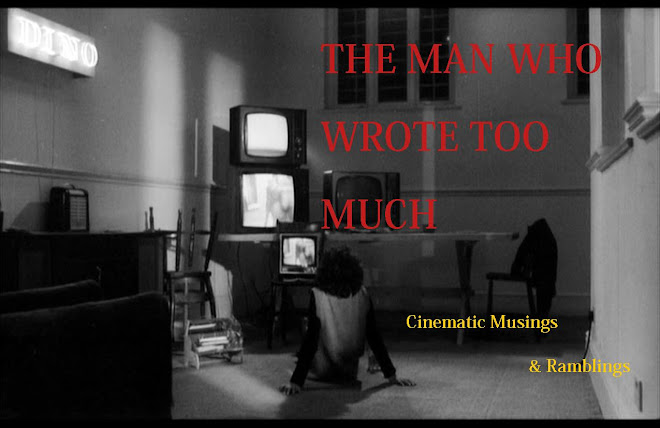When reviewing examples of meditative cinema you often find
yourself getting bound up in cliché. Not just in the terms you end up churning
out (haunting/contemplative/ethereal et al) but in the reference points you
turn to. Some people stand as such totemic examples of this brand of film in
their national cinemas that you can’t help but consciously refer to them.
Japan, you think Ozu. Sweden, you think Bergman. Iran, you think Kiarostami.
Belgium, you think the Dardenne’s etc etc, and so it goes with Russian cinema,
where the name Tarkovsky looms long over subsequent works.
Andrey Zvyagintsev’s debut feature The Return was as subject to this as
any recent Russian feature in the wake of its Golden Lion win at 2003's Venice Festival. Critics chose to make Stalker (1979) the main frame of reference,
and you can see where they were coming from. Like that picture, The Return employs a muted colour
palate, where most images are drained of vibrancy to the point where every
colour seems to be a variant on blue or grey, the emptied provincial towns,
looking shut down in a perpetual loop of dull bank holidays, decaying warehouses
creating a dystopian atmosphere echoing Stalker’s ‘The Zone’ early in the film,
and of course both films are framed within a foreboding journey and discovery
template. Equally valid arguments though could be made for comparing the film
with other art house road trips such as Theo Angelopoulos’ Landscapes in the
Mist (1988) and Michelangelo
Antonioni’s stunning mist-strewn evocation of the Italian Po Delta in Il
Grido (1957).
Like most films of this ilk, the outward
narrative of The Return is stripped
to a bare bones approach and is all the better for it. The film concerns two
brothers Ivan (Ivan Dobronravov) a mummy’s boy on the cusp of adolescence and
Andrey (Vladimir Garin) a few years older and determined to impress his peers.
One summer day they return home to be informed that their father (Konstantin
Lavronenko) unseen since they were toddlers, has returned and is intending to
take them on a fishing trip to make up for lost time.
Rather than a heartfelt family reunion
though, the father is met with immediate suspicion, especially by Ivan, who
attempts to test his father’s patience from the off and questions his motives
for returning. Not that his suspicions are completely unfounded as the father
acts cold and brusque, toying emotionally with the brothers and lambasting them
for perceived weaknesses in their characters.
The first half of the film takes place
largely in the confines of the fathers 1980s Gaz Volga (imagine a Volvo made
with Iron Curtain spit and gristle cost cutting economy rather than Swedish
proficiency), and concentrates on the less ecstatic aspects of family road
trips, the boredom of confinement, the monotony of unvarying landscapes and the
resulting shortened tempers of those caught up in this scenario.
As the film progresses, a sense of menace
and dread begins to take hold as we are invited to share in the brothers’
suspicion of the increasingly authoritarian actions of their father. By the
time the trio arrive at their fishing destination on a secluded mid-lake island, this ominous atmosphere builds towards an almost inevitably crushing
conclusion.
The film invites itself up as a
emblematical template for varied analytical approaches, be that theological
(with the father’s introduction to the film purposely framed to echo Andrea
Mategna’s The Lamentation over
the Dead Christ and the misty
hooded crossing of a lake bringing to mind Charon ferrying souls across the
River Styx), psychoanalytical (the whole parental relationship dichotomy being
a field day for Freudian scholars) or allegorical (certainly native viewers may
be drawn towards an analysis in which the old guard of the USSR has a
traumatised relationship with contemporary Russia).
I found taking the film at face value
perfectly rewarding though. The strained relationship creating a perfectly
intriguing premise. I found it reminiscent of when you would visit friends
whose father’s you found overly strict as a child, and you stand there
witnessing these relationships wondering what their motive was, is their father
a cruel man? Does he detest the responsibility of having children? Or is he
simply trying to teach important lessons in a slightly misguided way? Making
sure the child has the necessary attributes of a ‘man’ so that the world can’t
take advantage? This is the kind of scenario played out here. The film provides a steady stream of intimations that the father has an ulterior motive for the
trip (an eventual mcguffin), and gives very subtle hints as to the
reasons for him being missing for 12 years, allowing the viewer to piece together their
own backstory of sorts.
This was a stunningly rewarding film
to view a second time. With hindsight, character motivations appear clearer and
in the case of the father, more forgiving than our initial viewing of him as a
stern beast of a man with the resulting actions having all the more devastating
an impact as a consequence. A large part of this can be put down to Konstantin Lavronenko’s
performance which is commendably nuanced behind a poker faced façade.
Unfortunately having knowledge of the
film's production provides an extra sense of melancholy to its proceedings
as Vladimar Garin suffered a bitterly ironic death in a drowning accident not
long after completion of the film. The fact casting an inevitable weight and long shadow over the
picture.
Predictably we return to Tarkovsky. His own
debut Ivan’s Childhood (1962) ends up providing one of the
most apt comparisons in the end. The innocence of youth cut short, the brutality
of responsibility being forced onto unready young shoulders. If the
responsibility of being a 21st century
Tarkovsky is to be pushed upon Zvyagintsev’s own shoulders, then with this and
his subsequent work so far, he’s doing a creditable job.
twitter.com/RadioFreeLee
twitter.com/RadioFreeLee

+2.JPG)
+7.png)
+5.JPG)
+7.jpg)
+5.jpg)
+8.jpg)
+2.jpg)
+5.jpg)
+7.jpg)
+4.png)
+5.png)
+8.png)



+1.JPG)
+3.JPG)
+4.JPG)
+1.JPG)
+2.JPG)
+4.JPG)
+1.JPG)
+2.JPG)
+3.JPG)